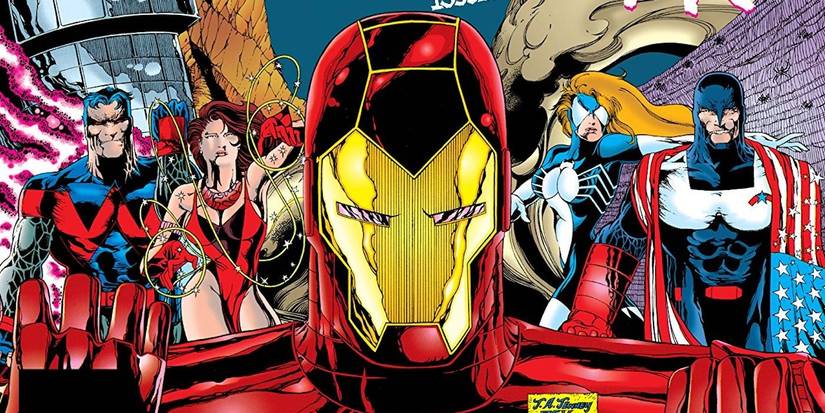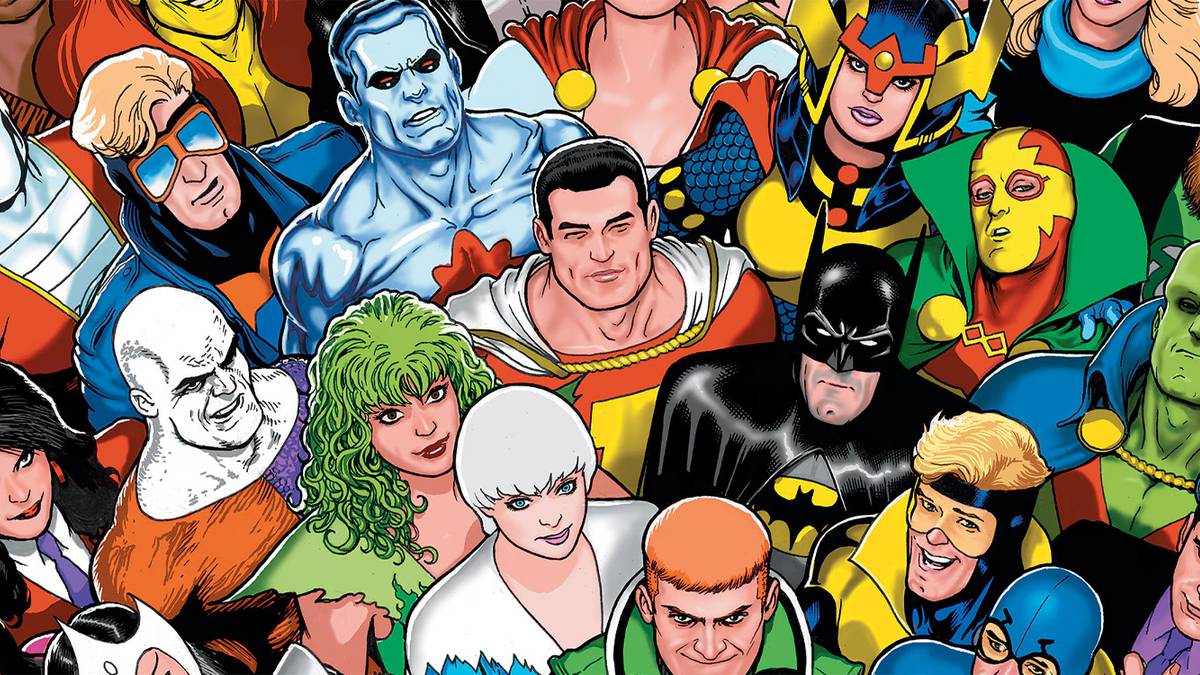Saving the world is hard enough, but it’s even harder for superheroes who don’t like each other very much. That’s why most superhero teams tend to get along, with some even becoming great friends. However, as fans saw with Marvel’s Thunderbolts film, superhero teams aren’t always “super friends”, at least at the start.
At times, both Marvel and DC have featured superhero teams that actually hated each other. Sometimes they manage to get through their problems by working together, but other times, it’s bad enough that the team breaks up. While bad interpersonal relationships can get in the way of stopping evil, heroes that don’t get along can be some of the most interesting teams to read about.
Force Works Was a Short-Lived Wannabe Avengers

The original line-up of Marvel’s Force Works teamImage via Marvel Comics
Force Works was the team that popped up after the West Coast Avengers were forced to shut down. After leaving the Avengers, Iron Man still wanted another super-team to work with, so he repurposed the West Coast Avengers roster as Force Works. However, the group struggled with its team chemistry from the beginning.
Even though Tony initially gave the role of leader to Wanda, he constantly subverted her commands to do his own thing. Meanwhile, the U.S. Agent’s attitude made him nearly impossible to deal with and prickly to most of the team. Worst of all, the team was ultimately disbanded after being betrayed by Tony Stark when he was briefly under the control of Kang the Conqueror in one of the worst Avengers stories of all time.
Justice League International’s Humor Came From the Heroes Never Getting Along
The Justice League International’s main gimmick is their unprofessionalism, so it’s no surprise that the team didn’t always get along. In the early era, they were vitriolic toward one another and usually solved problems through experience and power rather than any real teamwork.
When the JLI started, Batman was prickly and forcibly took the reins of command from the team. Guy Gardner was so disliked that the entire team celebrated when Batman knocked him out. Black Canary was frustrated by the men not respecting her as a woman, and Martian Manhunter was furious that no one on the team took things seriously. The JLI books are fantastic, but it’s no surprise that other DC heroes look back on this era with a bit of embarrassment.
Nextwave Couldn’t Stand Each Other, But United to Fight H.A.T.E.
From the beginning, Nextwave was designed as the ultimate dysfunctional super-team. It featured a group of C-list Marvel heroes who came together to battle an organization known as H.A.T.E. Since the heroes weren’t well known, it wasn’t a surprise when they were written somewhat out of character.
It’s hard to take a group seriously when its leader, Spectrum, is threatening to incinerate them all. The rest aren’t much better, each dealing with issues that make them borderline misanthropic. The only reason they succeed at all is their shared desire to defeat H.A.T.E. more than tear each other apart.
Extreme Justice Was a Group of C-Listers
In the comics, the team featured in Extreme Justice never actually had a name of their own. They’re believed to be just another splintered faction of the Justice League, from a time when there were far too many Justice League groups. Led by Captain Atom, the team was meant to be more proactive and avoid the red tape that came with working under the United Nations.
Most of the members struggled to get along at first. Captain Atom was a forceful leader who often rubbed others the wrong way, while Maxima’s status as a hero was questionable at best. Even Booster Gold and Blue Beetle went through a rough patch, barely getting along despite being on the same team. It’s no surprise the group lasted just over a year and is now mostly remembered as a roster of C-list DC heroes many forgot were ever part of the League.
Dark Avengers Were Norman Osborn’s Way of Taking Control
The Dark Avengers were superheroes for the sake of the camera. After the events of Secret Invasion, Norman Osborn gained significant power, and one of his first moves was to create organizations loyal to him. The Dark Avengers were meant to serve as his public-facing superhero team, standing in for the New Avengers. The twist was that every member was secretly a villain in disguise.
Since the team was assembled by Norman and made up entirely of supervillains, it’s no surprise the Dark Avengers hated each other. Daken manipulated an encounter between Norman and the Fantastic Four, while Bullseye couldn’t stand Daken for being untrustworthy. Their “Spider-Man” couldn’t control the symbiote and was always one step away from attacking the team, and Moonstone tried to play everyone against each other by sleeping around. The fact that they lasted as long as they did is impressive.
Justice League of America Fell Apart Because the Team Didn’t Believe in Each Other
Even at their best, the Justice League of America have struggled at times with poor team chemistry. Batman’s reveal that he had contingency plans to shut down the entire League nearly tore the team apart. Later, just before Infinite Crisis, the League actually did fall apart, with Superman, Batman, and Wonder Woman all turning their backs on each other for different reasons.
When they reassembled during the One Year Later era, everything was meant to be fixed for good. However, it wasn’t long before a new set of problems surfaced, starting with the Trinity suddenly being too busy to lead. Though they passed the reins to Black Canary, they continued holding shadow meetings behind her back, eventually leading Dinah to snap at all of them. On top of that, she had to deal with her husband, Ollie, and his friend Hal walking out to form their own team.
The Illuminati Failed Despite Their Intelligence
The Illuminati were meant to represent some of the Marvel Universe’s smartest Avengers, but were ultimately responsible for some of the team’s biggest mistakes. Nowhere was this clearer than in the build-up to 2015’s Secret Wars. As the heroes began confronting the Incursions, their conflicting views on how to handle the growing threat eventually drove them to turn on one another.
After initially welcoming Steve Rogers into the group, they had him removed once he proved too moral for the decisions they were facing. Namor later abandoned the group when they refused to follow through on the actions they’d planned. Though he eventually changed his mind, it was too late, and Black Panther set him up to be killed for his attempted invasion of Wakanda.
Titans East Hated Each Other As Much As the Real Titans
Even though the team was formed by Deathstroke, Titans East were never intended to be a supervillain group. Instead, they existed solely so Slade could convince the Teen Titans that children shouldn’t be heroes. Since the group was specifically assembled to neutralize the Titans, it’s no surprise they didn’t get along well.
Batgirl never wanted to be part of the team and only joined because of Slade’s mind control serum. Inertia and Match were actual villains who joined after being manipulated by Slade. Even Bombshell hated both the original Titans she spied on and the Titans East.
Champions Disbanded Because They Couldn’t Stand Each Other Anymore
If a super-team is going to have friction, it’s usually at the beginning of their adventures. With the original Champions, however, all their issues surfaced at the very end. The team had been assembled as a vehicle for many of Marvel’s B-list characters of the era, but when the team’s ongoing book was canceled, they actually stayed together.
That all changed with Spectacular Spider-Man #17, which showed the team’s messy finale. After a battle with a group of fake Sentinels, the members began exploding at each other in anger. Even longtime friends Angel and Iceman snapped at each other before Angel finally got fed up and kicked them out of his base.
The Ultimates Was Packed With Unlikable Characters
It was a miracle the original Ultimates ever got anything done. The 2000s iteration of the team came from an era of celebrity culture and existed in a world where nearly every member was intensely unlikable. On top of that, the first major enemy they faced was one of their own, as Bruce Banner let his rage take over and transformed into the Hulk, forcing the rest of the team to shut him down.
But the issue wasn’t just the Hulk. Captain America struggled to adjust to the modern world, making him brash and abrasive. Meanwhile, Ant-Man and the Wasp’s relationship was far more abusive than in the original universe, culminating in Captain America personally beating Hank up, only for Janet to go back to Hank by the end. Despite being one of the better books from the original Ultimate Universe, the Ultimates were a true mess of an organization.

